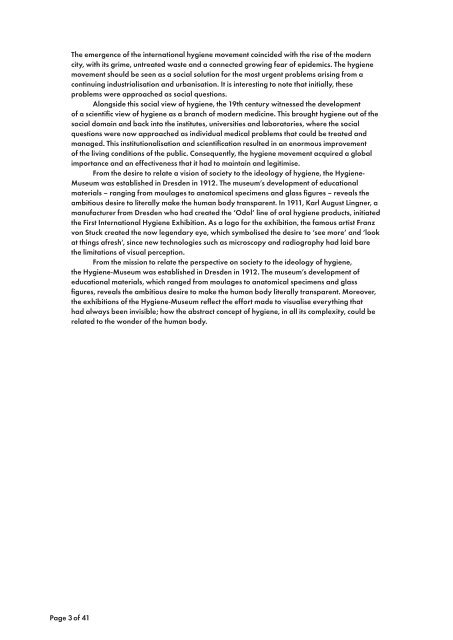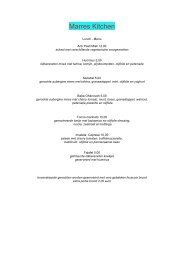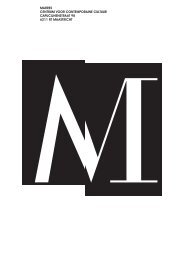Hygiene The story of a museum - Marres
Hygiene The story of a museum - Marres
Hygiene The story of a museum - Marres
Create successful ePaper yourself
Turn your PDF publications into a flip-book with our unique Google optimized e-Paper software.
<strong>The</strong> emergence <strong>of</strong> the international hygiene movement coincided with the rise <strong>of</strong> the modern<br />
city, with its grime, untreated waste and a connected growing fear <strong>of</strong> epidemics. <strong>The</strong> hygiene<br />
movement should be seen as a social solution for the most urgent problems arising from a<br />
continuing industrialisation and urbanisation. It is interesting to note that initially, these<br />
problems were approached as social questions.<br />
Alongside this social view <strong>of</strong> hygiene, the 19th century witnessed the development<br />
<strong>of</strong> a scientific view <strong>of</strong> hygiene as a branch <strong>of</strong> modern medicine. This brought hygiene out <strong>of</strong> the<br />
social domain and back into the institutes, universities and laboratories, where the social<br />
questions were now approached as individual medical problems that could be treated and<br />
managed. This institutionalisation and scientification resulted in an enormous improvement<br />
<strong>of</strong> the living conditions <strong>of</strong> the public. Consequently, the hygiene movement acquired a global<br />
importance and an effectiveness that it had to maintain and legitimise.<br />
From the desire to relate a vision <strong>of</strong> society to the ideology <strong>of</strong> hygiene, the <strong>Hygiene</strong>-<br />
Museum was established in Dresden in 1912. <strong>The</strong> <strong>museum</strong>’s development <strong>of</strong> educational<br />
materials – ranging from moulages to anatomical specimens and glass figures – reveals the<br />
ambitious desire to literally make the human body transparent. In 1911, Karl August Lingner, a<br />
manufacturer from Dresden who had created the ‘Odol’ line <strong>of</strong> oral hygiene products, initiated<br />
the First International <strong>Hygiene</strong> Exhibition. As a logo for the exhibition, the famous artist Franz<br />
von Stuck created the now legendary eye, which symbolised the desire to ‘see more’ and ‘look<br />
at things afresh’, since new technologies such as microscopy and radiography had laid bare<br />
the limitations <strong>of</strong> visual perception.<br />
From the mission to relate the perspective on society to the ideology <strong>of</strong> hygiene,<br />
the <strong>Hygiene</strong>-Museum was established in Dresden in 1912. <strong>The</strong> <strong>museum</strong>’s development <strong>of</strong><br />
educational materials, which ranged from moulages to anatomical specimens and glass<br />
figures, reveals the ambitious desire to make the human body literally transparent. Moreover,<br />
the exhibitions <strong>of</strong> the <strong>Hygiene</strong>-Museum reflect the effort made to visualise everything that<br />
had always been invisible; how the abstract concept <strong>of</strong> hygiene, in all its complexity, could be<br />
related to the wonder <strong>of</strong> the human body.<br />
Page 3 <strong>of</strong> 41






